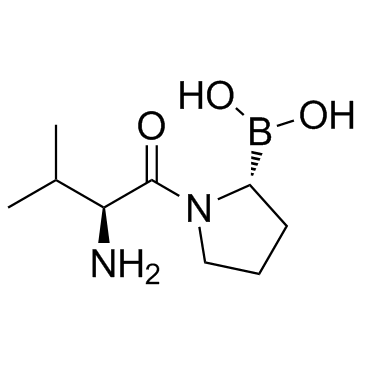149682-77-9
| Name | [(2R)-1-[(2S)-2-amino-3-methylbutanoyl]pyrrolidin-2-yl]boronic acid |
|---|---|
| Synonyms |
Valinyl-L-Boroproline
[(2R)-1-[(2S)-2-amino-3-methylbutanoyl]pyrrolidin-2-yl]boronic acid Boronic acid,((2R)-1-((2S)-2-amino-3-methyl-1-oxobutyl)-2-pyrrolidinyl) [(2R)-1-(L-valyl)pyrrolidin-2-yl]boronic acid Boronic acid, B-[(2R)-1-[(2S)-2-amino-3-methyl-1-oxobutyl]-2-pyrrolidinyl]- PT 100 Talabostat(PT100) Talabostat ValboroPro [(2R)-1-(L-Valyl)-2-pyrrolidinyl]boronic acid |
| Description | Talabostat (PT100, Val-boroPro) is a potent, nonselective and orally available dipeptidyl peptidase IV (DPP-IV) inhibitor with a Ki of 0.18 nM. |
|---|---|
| Related Catalog | |
| Target |
Ki: 0.18 nM (DPP-IV), 1.5 nM (DPP8), 0.76 nM (DPP9)[1] |
| In Vitro | Talabostat is a nonselective DPP-IV inhibitor, inhibiting DPP8/9, FAP, DPP2 and some other DASH family enzymes essentially as potently as it inhibits DPP-IV[1]. Talabostat stimulates the immune system by triggering a proinflammatory form of cell death in monocytes and macrophages known as pyroptosis. The inhibition of two serine proteases, DPP8 and DPP9, activates the proprotein form of caspase-1 independent of the inflammasome adaptor ASC[2]. Talabostat competitively inhibits the dipeptidyl peptidase (DPP) activity of FAP and CD26/DPP-IV, and there is a high-affinity interaction with the catalytic site due to the formation of a complex between Ser630/624 and the boron of talabostat[3]. |
| In Vivo | Talabostat can stimulate immune responses against tumors involving both the innate and adaptive branches of the immune system. In WEHI 164 fibrosarcoma and EL4 and A20/2J lymphoma models, PT-100 causes regression and rejection of tumors. The antitumor effect appears to involve tumor-specific CTL and protective immunological memory. Talabostat treatment of WEHI 164-inoculated mice increases mRNA expression of cytokines and chemokines known to promote T-cell priming and chemoattraction of T cells and innate effector cells[3]. Talabostat treated mice show significant less fibrosis and FAP expression is reduced. Upon PT100 treatment, significant differences in the MMP-12, MIP-1α, and MCP-3 mRNA expression levels in the lungs are also observed. Treatment with PT100 in this murine model of pulmonary fibrosis has an anti-fibro-proliferative effect and increases macrophage activation[4]. |
| Animal Admin | Mice: BLM (0.5mg/kg/day) is administered on days -7, -6, -5, -2, -1, 0 in the nostrils of male mice. Talabostat (40 µg/mouse) or vehicle (0.9% NaCl) is dosed per os twice daily from day 1-14. MRI is performed before BLM and at days 0, 7 and 14. After the last MRI acquisition, animals are euthanised and the lungs harvested for histological and quantitative real-time polymerase chain reaction (qRT-PCR) analyses[4]. |
| References |
| Density | 1.2±0.1 g/cm3 |
|---|---|
| Boiling Point | 421.4±55.0 °C at 760 mmHg |
| Molecular Formula | C9H19BN2O3 |
| Molecular Weight | 214.070 |
| Flash Point | 208.7±31.5 °C |
| Exact Mass | 214.148880 |
| PSA | 86.79000 |
| LogP | 0.01 |
| Vapour Pressure | 0.0±2.3 mmHg at 25°C |
| Index of Refraction | 1.514 |
| HS Code | 2933990090 |
|---|
| HS Code | 2933990090 |
|---|---|
| Summary | 2933990090. heterocyclic compounds with nitrogen hetero-atom(s) only. VAT:17.0%. Tax rebate rate:13.0%. . MFN tariff:6.5%. General tariff:20.0% |
